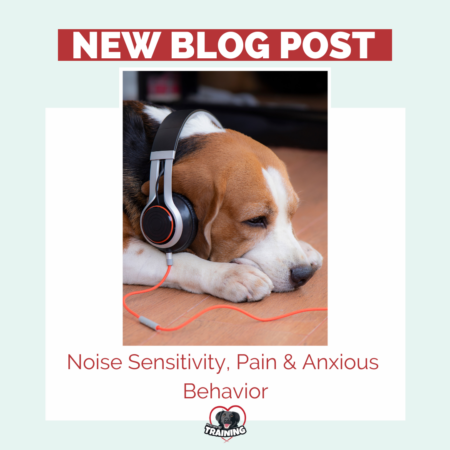Once again, let me first start this post with my standard disclaimer: I AM NOT A VET. But as a trainer who specializes in fear, aggression, reactivity and separation anxiety, I always ask clients about their dog’s medical history and I’m always scanning for red flags that may require a vet check. Why? Because we know there is a strong connection between physical health and behavior and open communication between the trainer, client and vet benefits the dog’s long term success.
I’ve written in the past about the link between physical pain and behavior and given examples of clients where I suspected the dog was in pain based on my behavior consult and recommended the client have a vet check, which confirmed the dog indeed did have pain or something physical going on. Dogs can be very stoic creatures. Pain or other physical issues can cause behavior changes. Any sudden behavior change, whether it’s a lapse in housetraining, reactivity, a regression in separation anxiety or anything else new, requires a vet check. A competent, qualified trainer will refer you to a vet when needed or help you know what is important to communicate to the vet. A less qualified trainer may not know how to identify these signs or may run a client through an extensive training program, which likely won’t be successful if the dog is actually in pain and that’s causing the behavior changes. My standard protocol when dealing with noise-related behavior issues is to refer for a vet check for a thorough physical exam to determine if pain is a factor.
Here’s a recent case study as an example. Most recently I had a client who presented with severe and increasingly generalizing noise sensitivity to beeps and timers but started to generalize to the room these beeps were coming from, to the point where the dog was trying to get out of the house into the yard when she heard noises in the home. After reviewing the dog’s history in my initial consult, including rescue history, time with the family, training history, the recent addition of a newborn and medical history, I strongly felt this dog was likely experiencing pain. Was the newborn baby triggering the dog? That’s definitely what the family thought. But, as part of the history, the family mentioned the dog had previously been hit by a car, and even though the dog had been cleared by the surgeon and general vet as “recovered” and “fine” from her injuries, based on my behavior consult with them I felt strongly that my recommendation to refer them to a VB (vet behaviorist) for a consult for a pain assessment and/or behavior meds was appropriate. In my view, the dog was in pain or if she wasn’t, then she was incredibly anxious and the VB could do a meds consult, so either way, the VB would be able to help.
However, the family, because they had recently had a baby, were more convinced that the dog was having difficulty adjusting to the baby and was not in pain, because the surgeon and the general vet had both cleared the dog as “fine” and “recovered” from her car accident. They were initially hesitant to pursue my recommendation and also cost was an obstacle. We discussed just starting training and noise desensitization, but I was hesitant to begin this process without a medical confirmation the dog was not in pain, as I didn’t want to risk the dog associating training with pain and I was skeptical we’d make any progress in her current over-threshold state.
A few more months passed and the dog continued to generalize and get worse with noises. The family finally scheduled an appointment with the VB that I recommended. I sent over my notes and communicated my concerns ahead of their appointment. The VB on initial exam noted “discomfort/apprehension when attempting to palpate left knee…would put more weight on right hind foot than left….sometimes to the point of avoiding weight on left side. My concern is – what component of discomfort is causing the behavior changes we are observing.” A month long pain med trial was prescribed. No anti-anxiety meds were started, only an NSAID.
At the one month follow-up, owners reported the dog’s noise sensitivity was less intense, her recovery was much faster and for some triggers, she did not react at all – a huge improvement. And since the pain medication had no anxiety relieving properties, we can conclude the pain relief is making her more comfortable and making her less anxious about noises.
The newborn baby was a red herring and the dog was not anxious about the baby, as I suspected. The dog was indeed in pain, as I initially suspected. (And, it’s worth noting, I did this case ALL remotely!) When we relieved the pain, the noise sensitivity almost completely resolved.
This is consistent with the findings of a 2018 study by Fagundes et al. Noise sensitivity was compared between two groups of dogs, those with and without pain. Those dogs with discomfort and noise sensitivity had onset of their signs later in life (on average 4 years later) as well as a more generalized association with environments and avoidance of those environments, not just the noises. These dogs responded well to treatment when the pain was identified and treated.
I received an email from the client after their follow-up saying “Our next step is to have her checked out by our surgeon to see if there is anything that can be done physically, or if we should continue with long term pain medications. We’re grateful that you encouraged us to explore this route!”
The most recent update is that they consulted with a different surgeon and in fact determined there is “instability in her knee, which can be helped with surgery.”
As you can see, a less qualified trainer may not have felt confident in their initial assessment to encourage the clients to pursue the specialist consult or may have wasted time and resources focusing on the new baby as the trigger, and that wouldn’t have resolved the dog’s issues. Or maybe they would have not pushed since the surgeon and general vet cleared the dog as “fine” but I knew this dog needed another opinion and it wouldn’t be a waste of the client’s money. Yes, training can be expensive and so can seeing a specialist. But, wasting money on training that isn’t going to get you results is also expensive. A competent trainer is worth the investment. And if you don’t know what to look for in a professional, this post can help.
If you are a vet, I’d love to speak with you about how I can help you and your clients remotely, Please reach out and let’s chat! As you can see, this was part case study, part testament to the power of remote training and part testimonial to the importance of having a competent, qualified behavior consultant handling cases. I partner with vets all over the country to help their clients, and I’d love to help your too, so please contact me and let’s chat for a bit so I can introduce myself and explain how I handle cases and how we might work together.
Be sure to sign up for my free weekly newsletter so you don’t miss out on big announcements, videos, personal stories, client successes and more!
Contact me and schedule a session if you need help.
Happy training!
![]()




